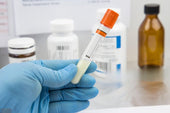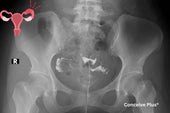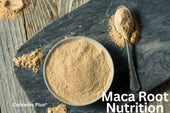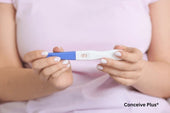What is Infertile Discharge and How It Prevents Conception?

Cervical discharge, or cervical mucus, is a fluid secreted by glands in the cervix. It is composed mainly of water, proteins, enzymes, and electrolytes. The discharge protects the uterus from infections by stopping the entry of harmful foreign agents [1].
Cervical discharge can also help or hinder sperm movement, depending on the phase of the menstrual cycle. When it helps transport sperm cells into the uterus, it is called fertile discharge. On the other hand, when it hinders sperm movement, it is called infertile discharge.
Fertile Cervical Mucus During Ovulation
As ovulation approaches, an increase in estrogen levels causes cervical mucus to become clear and stretchy, resembling raw egg white in texture [2]. The high water content and nutrient-rich environment of egg white cervical mucus is ideal for sperm survival and movement.
The thin, slippery consistency allows sperm to swim quickly through the cervix and into the uterus, increasing the chances of fertilization. Because of these properties, the vaginal discharge around ovulation is characterized as fertile discharge. This fertile phase typically lasts a few days, known as the female fertility window.
Infertile Cervical Mucus Outside Ovulation
During most of the menstrual cycle, when ovulation is not occurring, cervical mucus becomes thicker and more viscous. This infertile discharge serves a protective role by making it harder for sperm to penetrate the cervix.
In addition to stopping sperm, this type of mucus helps prevent bacteria and other foreign particles from entering the uterus, lowering the risk of infections and improving overall reproductive health [1].
Infertility Discharge During Ovulation
Although the fertile window is supposed to have a fertile cervical mucus, some women may experience an infertile discharge even during ovulation. In these cases, the mucus may not develop the typical clear and stretchy texture needed for sperm survival.
The infertile discharge might look similar to the fertile type, but its chemical composition may not allow the sperm to reach the egg for fertilization. Such changes in cervical discharge can result from factors that influence hormonal balance or affect the cervical environment.
What are Other Infertility Symptoms?
Besides abnormal changes in cervical mucus, your body hints at infertility in many other ways. Irregular menstrual cycles, where periods come too early or too late, are among the primary indications of problems with fertility [3].
Some women experience pelvic pain that can be mild or strong. Such pain can result from problems with the reproductive system, such as sexually transmitted infections or blockage [4]. Hormonal imbalances can also negatively affect reproductive functioning, making conception less likely.
Other infertility symptoms can include unexpected weight changes and mood swings. Experiencing such signs once in a while may not be an issue. However, if such signs persist, it is recommended to seek professional advice to avoid serious complications.
Possible Cervical Mucus Issues
Here are some possible cervical mucus issues that can lead to infertile discharge during ovulation:
-
Hormonal Imbalances
Hormonal imbalances, particularly low estrogen levels, can prevent cervical mucus from becoming thin and stretchy during ovulation. Without the right hormonal signals, the mucus may remain thick and inhibit the sperm movement.
-
Infections and Inflammation
Cervical infections or inflammation can negatively influence the chemical makeup of cervical mucus [5]. These conditions can disrupt the normal consistency and composition of the mucus, making it less supportive for sperm during the fertile window.
-
Medication Effects
Certain medications, such as hormonal treatments or contraceptives, can influence the properties of cervical mucus. These medications and treatments can result in a mucus discharge that is not optimal for sperm survival, even at the time of ovulation.
-
Lifestyle Factors
Lifestyle factors, including stress, diet, and overall health, may also impact cervical mucus quality. High-stress levels or poor nutritional status can affect hormonal balance and, as a result, the consistency of cervical mucus. Constant exposure to such factors can lead to infertile cervical discharge and lower the chances of conception.
Addressing Cervical Mucus Changes
Understanding the types of cervical mucus is significantly helpful for women trying to conceive. Monitoring changes in mucus consistency can provide valuable insights into reproductive health.
If you notice that your mucus seems unusual during your fertile days, it's a good idea to speak with your doctor. They might suggest some tests to see if there’s an underlying issue and help you find the right fertility treatment to boost your chances of conceiving.
If you're curious about how cervical mucus quality influences reproductive potential, explore our guide on fertile vs infertile sperm for more in-depth insights.
The Bottom Line
The cervix produces a mucus-like discharge which changes in composition and consistency throughout the menstrual cycle. During ovulation, it becomes thin and stretchy, which supports the transport of sperm cells into the uterus.
However, certain issues with cervical mucus can result in infertile discharge during ovulation. Infertile discharge refers to thick and viscous mucus that inhibits sperm movement. Improving dietary and lifestyle habits can help resolve problems with cervical discharge in some cases. In other cases, you need proper medical care to diagnose and address the underlying issue.
Resources Used
- Adnane, M., & Meade, K. G. (2018). Cervico-vaginal mucus (CVM) – an accessible source of immunologically informative biomolecules. Veterinary Research Communications, 42(4), 255. https://doi.org/10.1007/s11259-018-9734-0
- Professional, C. C. M. (2025, February 12). Cervical mucus. Cleveland Clinic. https://my.clevelandclinic.org/health/body/21957-cervical-mucus
- Irregular periods. (2025, March 19). Cleveland Clinic. https://my.clevelandclinic.org/health/diseases/14633-abnormal-menstruation-periods
- Garcia, M. R., Leslie, S. W., & Wray, A. A. (2024, April 20). Sexually transmitted infections. StatPearls - NCBI Bookshelf. https://www.ncbi.nlm.nih.gov/books/NBK560808/
- Iqbal, U., Carlson, K., & Wills, C. (2025, January 21). Cervicitis. StatPearls - NCBI Bookshelf. https://www.ncbi.nlm.nih.gov/books/NBK562193/
































